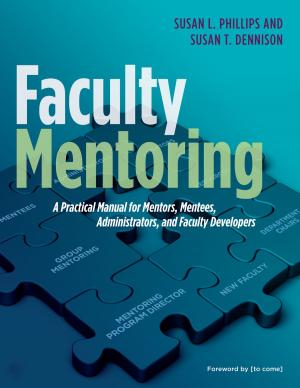Disrupting the Culture of Silence
Confronting Gender Inequality and Making Change in Higher Education
Nonfiction, Reference & Language, Education & Teaching, Educational Theory, Multicultural Education, Higher Education| Author: | ISBN: | 9781620362204 | |
| Publisher: | Stylus Publishing | Publication: | March 1, 2015 |
| Imprint: | Stylus Publishing | Language: | English |
| Author: | |
| ISBN: | 9781620362204 |
| Publisher: | Stylus Publishing |
| Publication: | March 1, 2015 |
| Imprint: | Stylus Publishing |
| Language: | English |
What do women academics classify as challenging, inequitable, or “hostile” work environments and experiences? How do these vary by women’s race/ethnicity, rank, sexual orientation, or other social locations?
How do academic cultures and organizational structures work independently and in tandem to foster or challenge such work climates?
What actions can institutions and individuals–independently and collectively–take toward equity in the academy?
Despite tremendous progress toward gender equality and equity in institutions of higher education, deep patterns of discrimination against women in the academy persist. From the “chilly climate” to the “old boys’ club,” women academics must navigate structures and cultures that continue to marginalize, penalize, and undermine their success.
This book is a “tool kit” for advancing greater gender equality and equity in higher education. It presents the latest research on issues of concern to them, and to anyone interested in a more equitable academy. It documents the challenging, sometimes hostile experiences of women academics through feminist analysis of qualitative and quantitative data, including narratives from women of different races and ethnicities across disciplines, ranks, and university types.
The contributors’ research draws upon the experiences of women academics including those with under-examined identities such as lesbian, feminist, married or unmarried, and contingent faculty. And, it offers new perspectives on persistent issues such as family policies, pay and promotion inequalities, and disproportionate service burdens. The editors provide case studies of women who have encountered antagonistic workplaces, and offer action steps, best practices, and more than 100 online resources for individuals navigating similar situations.
Beyond women in academe, this book is for their allies and for administrators interested in changing the climates, cultures, and policies that allow gender inequality to exist on their campuses, and to researchers/scholars investigating these phenomena. It aims to disrupt complacency amongst those who claim that things are “better” or “good enough” and to provide readers with strategies and resources to counter barriers created by culture, climate, or institutional structures.
FOREWORD—Penny A. Pasque
ACKNOWLEDGMENTS
INTRODUCTION
From People to Policies: Enduring Inequalities and Inequities for Women Academics—Kris De Welde and Andi Stepnick
PART ONE: THE STRUCTURE
1. GLASS CEILINGS AND GATED COMMUNITIES IN HIGHER EDUCATION—Robert J. Hironimus-Wendt and Doreen A. Dedjoe
2. CHALLENGES OF RACE AND GENDER FOR BLACK WOMEN IN THE ACADEMY—Candice P. Baldwin and Monica D. Griffin
3. CONTINGENT APPOINTMENTS AND THE DIMINISHING VOICE, AGENCY, AND PROFESSIONALISM OF WOMEN—Cecile H. Sam and Adrianna Kezar
4. FACULTY GENDER INEQUITY AND THE “JUST SAY NO TO SERVICE” FAIRY TALE—Karen Pyke
CASE STUDY: LECTURER BARNES
PART TWO: STRUCTURE MEETS CULTURE
5. THE INFLUENCE OF DEPARTMENTAL CULTURE ON ACADEMIC PARENTS’ PRO-WORK BEHAVIORS—Julie A. Kmec, Shanyuan Foo, and Amy S. Wharton
6. ASSIMILATING TO THE NORM: Academic Women’s Experiences With Work-Family Policies—Catherine Richards Solomon
7. THE ELDERCARE CRISIS AND IMPLICATIONS FOR WOMEN FACULTY—Gretal Leibnitz and Briana Morrison
CASE STUDY: GRADUATE STUDENT CHASTAIN
PART THREE: EXCLUSIONARY CULTURES
8. PERPETUATING INEQUALITY THROUGH THE CANONS OF DISCIPLINARY KNOWLEDGE—Barret Katuna
9. CHARACTERISTICS AND PERCEPTIONS OF WOMEN OF COLOR FACULTY NATIONALLY—Corinne Castro
10. WOMEN SOCIOLOGISTS AND THE QUESTION OF INCLUSION IN THE ACADEMY—Kristin Marsh
11. NOT THE IDEAL PROFESSOR: Gender in the Academy—Laura Hirshfield
12. INTERSECTIONAL INVISIBILITY AND THE ACADEMIC WORK EXPERIENCES OF LESBIAN FACULTY—Diana Bilimoria and Abigail J. Stewart
CASE STUDY: PROFESSOR LIU
PART FOUR: HOSTILE CLIMATES
13. GENDER DIFFERENCES IN FACULTY RESPONSES TO CONTRAPOWER HARASSMENT—Claudia Lampman
14. CONFRONTING FACULTY INCIVILITY AND MOBBING—Susan K. Gardner and Amy Blackstone
15. WOMEN OF COLOR IN THE ACADEMY: From Trauma to Transformation—Molly Everett Davis, Halaevalu F. Ofahengaue Vakalahi, and Renay Scales
CASE STUDY: PROFESSOR. SMITH
PART FIVE: TOOLS FOR CHANGING THE ACADEMY
16. MULTIPLE PERSPECTIVES FOR CREATING CHANGE IN THE ACADEMY—Elizabeth J. Allan
17. WITH SO MANY PROBLEMS, WHERE DO WE BEGIN?—Building a Toolbox for Change
Abby L. Ferber
CASE STUDIES OF RESISTANCE AND FEMINIST CHANGE
ONLINE RESOURCES
ABOUT THE CONTRIBUTORS
INDEX
How do academic cultures and organizational structures work independently and in tandem to foster or challenge such work climates?
What actions can institutions and individuals–independently and collectively–take toward equity in the academy?
Despite tremendous progress toward gender equality and equity in institutions of higher education, deep patterns of discrimination against women in the academy persist. From the “chilly climate” to the “old boys’ club,” women academics must navigate structures and cultures that continue to marginalize, penalize, and undermine their success.
This book is a “tool kit” for advancing greater gender equality and equity in higher education. It presents the latest research on issues of concern to them, and to anyone interested in a more equitable academy. It documents the challenging, sometimes hostile experiences of women academics through feminist analysis of qualitative and quantitative data, including narratives from women of different races and ethnicities across disciplines, ranks, and university types.
The contributors’ research draws upon the experiences of women academics including those with under-examined identities such as lesbian, feminist, married or unmarried, and contingent faculty. And, it offers new perspectives on persistent issues such as family policies, pay and promotion inequalities, and disproportionate service burdens. The editors provide case studies of women who have encountered antagonistic workplaces, and offer action steps, best practices, and more than 100 online resources for individuals navigating similar situations.
Beyond women in academe, this book is for their allies and for administrators interested in changing the climates, cultures, and policies that allow gender inequality to exist on their campuses, and to researchers/scholars investigating these phenomena. It aims to disrupt complacency amongst those who claim that things are “better” or “good enough” and to provide readers with strategies and resources to counter barriers created by culture, climate, or institutional structures.
FOREWORD—Penny A. Pasque
ACKNOWLEDGMENTS
INTRODUCTION
From People to Policies: Enduring Inequalities and Inequities for Women Academics—Kris De Welde and Andi Stepnick
PART ONE: THE STRUCTURE
1. GLASS CEILINGS AND GATED COMMUNITIES IN HIGHER EDUCATION—Robert J. Hironimus-Wendt and Doreen A. Dedjoe
2. CHALLENGES OF RACE AND GENDER FOR BLACK WOMEN IN THE ACADEMY—Candice P. Baldwin and Monica D. Griffin
3. CONTINGENT APPOINTMENTS AND THE DIMINISHING VOICE, AGENCY, AND PROFESSIONALISM OF WOMEN—Cecile H. Sam and Adrianna Kezar
4. FACULTY GENDER INEQUITY AND THE “JUST SAY NO TO SERVICE” FAIRY TALE—Karen Pyke
CASE STUDY: LECTURER BARNES
PART TWO: STRUCTURE MEETS CULTURE
5. THE INFLUENCE OF DEPARTMENTAL CULTURE ON ACADEMIC PARENTS’ PRO-WORK BEHAVIORS—Julie A. Kmec, Shanyuan Foo, and Amy S. Wharton
6. ASSIMILATING TO THE NORM: Academic Women’s Experiences With Work-Family Policies—Catherine Richards Solomon
7. THE ELDERCARE CRISIS AND IMPLICATIONS FOR WOMEN FACULTY—Gretal Leibnitz and Briana Morrison
CASE STUDY: GRADUATE STUDENT CHASTAIN
PART THREE: EXCLUSIONARY CULTURES
8. PERPETUATING INEQUALITY THROUGH THE CANONS OF DISCIPLINARY KNOWLEDGE—Barret Katuna
9. CHARACTERISTICS AND PERCEPTIONS OF WOMEN OF COLOR FACULTY NATIONALLY—Corinne Castro
10. WOMEN SOCIOLOGISTS AND THE QUESTION OF INCLUSION IN THE ACADEMY—Kristin Marsh
11. NOT THE IDEAL PROFESSOR: Gender in the Academy—Laura Hirshfield
12. INTERSECTIONAL INVISIBILITY AND THE ACADEMIC WORK EXPERIENCES OF LESBIAN FACULTY—Diana Bilimoria and Abigail J. Stewart
CASE STUDY: PROFESSOR LIU
PART FOUR: HOSTILE CLIMATES
13. GENDER DIFFERENCES IN FACULTY RESPONSES TO CONTRAPOWER HARASSMENT—Claudia Lampman
14. CONFRONTING FACULTY INCIVILITY AND MOBBING—Susan K. Gardner and Amy Blackstone
15. WOMEN OF COLOR IN THE ACADEMY: From Trauma to Transformation—Molly Everett Davis, Halaevalu F. Ofahengaue Vakalahi, and Renay Scales
CASE STUDY: PROFESSOR. SMITH
PART FIVE: TOOLS FOR CHANGING THE ACADEMY
16. MULTIPLE PERSPECTIVES FOR CREATING CHANGE IN THE ACADEMY—Elizabeth J. Allan
17. WITH SO MANY PROBLEMS, WHERE DO WE BEGIN?—Building a Toolbox for Change
Abby L. Ferber
CASE STUDIES OF RESISTANCE AND FEMINIST CHANGE
ONLINE RESOURCES
ABOUT THE CONTRIBUTORS
INDEX
What do women academics classify as challenging, inequitable, or “hostile” work environments and experiences? How do these vary by women’s race/ethnicity, rank, sexual orientation, or other social locations?
How do academic cultures and organizational structures work independently and in tandem to foster or challenge such work climates?
What actions can institutions and individuals–independently and collectively–take toward equity in the academy?
Despite tremendous progress toward gender equality and equity in institutions of higher education, deep patterns of discrimination against women in the academy persist. From the “chilly climate” to the “old boys’ club,” women academics must navigate structures and cultures that continue to marginalize, penalize, and undermine their success.
This book is a “tool kit” for advancing greater gender equality and equity in higher education. It presents the latest research on issues of concern to them, and to anyone interested in a more equitable academy. It documents the challenging, sometimes hostile experiences of women academics through feminist analysis of qualitative and quantitative data, including narratives from women of different races and ethnicities across disciplines, ranks, and university types.
The contributors’ research draws upon the experiences of women academics including those with under-examined identities such as lesbian, feminist, married or unmarried, and contingent faculty. And, it offers new perspectives on persistent issues such as family policies, pay and promotion inequalities, and disproportionate service burdens. The editors provide case studies of women who have encountered antagonistic workplaces, and offer action steps, best practices, and more than 100 online resources for individuals navigating similar situations.
Beyond women in academe, this book is for their allies and for administrators interested in changing the climates, cultures, and policies that allow gender inequality to exist on their campuses, and to researchers/scholars investigating these phenomena. It aims to disrupt complacency amongst those who claim that things are “better” or “good enough” and to provide readers with strategies and resources to counter barriers created by culture, climate, or institutional structures.
FOREWORD—Penny A. Pasque
ACKNOWLEDGMENTS
INTRODUCTION
From People to Policies: Enduring Inequalities and Inequities for Women Academics—Kris De Welde and Andi Stepnick
PART ONE: THE STRUCTURE
1. GLASS CEILINGS AND GATED COMMUNITIES IN HIGHER EDUCATION—Robert J. Hironimus-Wendt and Doreen A. Dedjoe
2. CHALLENGES OF RACE AND GENDER FOR BLACK WOMEN IN THE ACADEMY—Candice P. Baldwin and Monica D. Griffin
3. CONTINGENT APPOINTMENTS AND THE DIMINISHING VOICE, AGENCY, AND PROFESSIONALISM OF WOMEN—Cecile H. Sam and Adrianna Kezar
4. FACULTY GENDER INEQUITY AND THE “JUST SAY NO TO SERVICE” FAIRY TALE—Karen Pyke
CASE STUDY: LECTURER BARNES
PART TWO: STRUCTURE MEETS CULTURE
5. THE INFLUENCE OF DEPARTMENTAL CULTURE ON ACADEMIC PARENTS’ PRO-WORK BEHAVIORS—Julie A. Kmec, Shanyuan Foo, and Amy S. Wharton
6. ASSIMILATING TO THE NORM: Academic Women’s Experiences With Work-Family Policies—Catherine Richards Solomon
7. THE ELDERCARE CRISIS AND IMPLICATIONS FOR WOMEN FACULTY—Gretal Leibnitz and Briana Morrison
CASE STUDY: GRADUATE STUDENT CHASTAIN
PART THREE: EXCLUSIONARY CULTURES
8. PERPETUATING INEQUALITY THROUGH THE CANONS OF DISCIPLINARY KNOWLEDGE—Barret Katuna
9. CHARACTERISTICS AND PERCEPTIONS OF WOMEN OF COLOR FACULTY NATIONALLY—Corinne Castro
10. WOMEN SOCIOLOGISTS AND THE QUESTION OF INCLUSION IN THE ACADEMY—Kristin Marsh
11. NOT THE IDEAL PROFESSOR: Gender in the Academy—Laura Hirshfield
12. INTERSECTIONAL INVISIBILITY AND THE ACADEMIC WORK EXPERIENCES OF LESBIAN FACULTY—Diana Bilimoria and Abigail J. Stewart
CASE STUDY: PROFESSOR LIU
PART FOUR: HOSTILE CLIMATES
13. GENDER DIFFERENCES IN FACULTY RESPONSES TO CONTRAPOWER HARASSMENT—Claudia Lampman
14. CONFRONTING FACULTY INCIVILITY AND MOBBING—Susan K. Gardner and Amy Blackstone
15. WOMEN OF COLOR IN THE ACADEMY: From Trauma to Transformation—Molly Everett Davis, Halaevalu F. Ofahengaue Vakalahi, and Renay Scales
CASE STUDY: PROFESSOR. SMITH
PART FIVE: TOOLS FOR CHANGING THE ACADEMY
16. MULTIPLE PERSPECTIVES FOR CREATING CHANGE IN THE ACADEMY—Elizabeth J. Allan
17. WITH SO MANY PROBLEMS, WHERE DO WE BEGIN?—Building a Toolbox for Change
Abby L. Ferber
CASE STUDIES OF RESISTANCE AND FEMINIST CHANGE
ONLINE RESOURCES
ABOUT THE CONTRIBUTORS
INDEX
How do academic cultures and organizational structures work independently and in tandem to foster or challenge such work climates?
What actions can institutions and individuals–independently and collectively–take toward equity in the academy?
Despite tremendous progress toward gender equality and equity in institutions of higher education, deep patterns of discrimination against women in the academy persist. From the “chilly climate” to the “old boys’ club,” women academics must navigate structures and cultures that continue to marginalize, penalize, and undermine their success.
This book is a “tool kit” for advancing greater gender equality and equity in higher education. It presents the latest research on issues of concern to them, and to anyone interested in a more equitable academy. It documents the challenging, sometimes hostile experiences of women academics through feminist analysis of qualitative and quantitative data, including narratives from women of different races and ethnicities across disciplines, ranks, and university types.
The contributors’ research draws upon the experiences of women academics including those with under-examined identities such as lesbian, feminist, married or unmarried, and contingent faculty. And, it offers new perspectives on persistent issues such as family policies, pay and promotion inequalities, and disproportionate service burdens. The editors provide case studies of women who have encountered antagonistic workplaces, and offer action steps, best practices, and more than 100 online resources for individuals navigating similar situations.
Beyond women in academe, this book is for their allies and for administrators interested in changing the climates, cultures, and policies that allow gender inequality to exist on their campuses, and to researchers/scholars investigating these phenomena. It aims to disrupt complacency amongst those who claim that things are “better” or “good enough” and to provide readers with strategies and resources to counter barriers created by culture, climate, or institutional structures.
FOREWORD—Penny A. Pasque
ACKNOWLEDGMENTS
INTRODUCTION
From People to Policies: Enduring Inequalities and Inequities for Women Academics—Kris De Welde and Andi Stepnick
PART ONE: THE STRUCTURE
1. GLASS CEILINGS AND GATED COMMUNITIES IN HIGHER EDUCATION—Robert J. Hironimus-Wendt and Doreen A. Dedjoe
2. CHALLENGES OF RACE AND GENDER FOR BLACK WOMEN IN THE ACADEMY—Candice P. Baldwin and Monica D. Griffin
3. CONTINGENT APPOINTMENTS AND THE DIMINISHING VOICE, AGENCY, AND PROFESSIONALISM OF WOMEN—Cecile H. Sam and Adrianna Kezar
4. FACULTY GENDER INEQUITY AND THE “JUST SAY NO TO SERVICE” FAIRY TALE—Karen Pyke
CASE STUDY: LECTURER BARNES
PART TWO: STRUCTURE MEETS CULTURE
5. THE INFLUENCE OF DEPARTMENTAL CULTURE ON ACADEMIC PARENTS’ PRO-WORK BEHAVIORS—Julie A. Kmec, Shanyuan Foo, and Amy S. Wharton
6. ASSIMILATING TO THE NORM: Academic Women’s Experiences With Work-Family Policies—Catherine Richards Solomon
7. THE ELDERCARE CRISIS AND IMPLICATIONS FOR WOMEN FACULTY—Gretal Leibnitz and Briana Morrison
CASE STUDY: GRADUATE STUDENT CHASTAIN
PART THREE: EXCLUSIONARY CULTURES
8. PERPETUATING INEQUALITY THROUGH THE CANONS OF DISCIPLINARY KNOWLEDGE—Barret Katuna
9. CHARACTERISTICS AND PERCEPTIONS OF WOMEN OF COLOR FACULTY NATIONALLY—Corinne Castro
10. WOMEN SOCIOLOGISTS AND THE QUESTION OF INCLUSION IN THE ACADEMY—Kristin Marsh
11. NOT THE IDEAL PROFESSOR: Gender in the Academy—Laura Hirshfield
12. INTERSECTIONAL INVISIBILITY AND THE ACADEMIC WORK EXPERIENCES OF LESBIAN FACULTY—Diana Bilimoria and Abigail J. Stewart
CASE STUDY: PROFESSOR LIU
PART FOUR: HOSTILE CLIMATES
13. GENDER DIFFERENCES IN FACULTY RESPONSES TO CONTRAPOWER HARASSMENT—Claudia Lampman
14. CONFRONTING FACULTY INCIVILITY AND MOBBING—Susan K. Gardner and Amy Blackstone
15. WOMEN OF COLOR IN THE ACADEMY: From Trauma to Transformation—Molly Everett Davis, Halaevalu F. Ofahengaue Vakalahi, and Renay Scales
CASE STUDY: PROFESSOR. SMITH
PART FIVE: TOOLS FOR CHANGING THE ACADEMY
16. MULTIPLE PERSPECTIVES FOR CREATING CHANGE IN THE ACADEMY—Elizabeth J. Allan
17. WITH SO MANY PROBLEMS, WHERE DO WE BEGIN?—Building a Toolbox for Change
Abby L. Ferber
CASE STUDIES OF RESISTANCE AND FEMINIST CHANGE
ONLINE RESOURCES
ABOUT THE CONTRIBUTORS
INDEX















